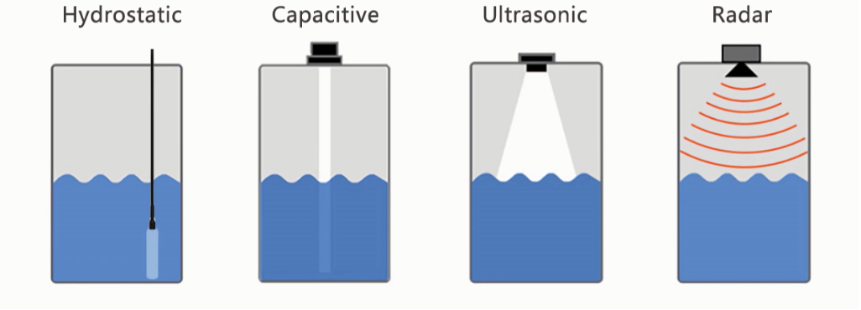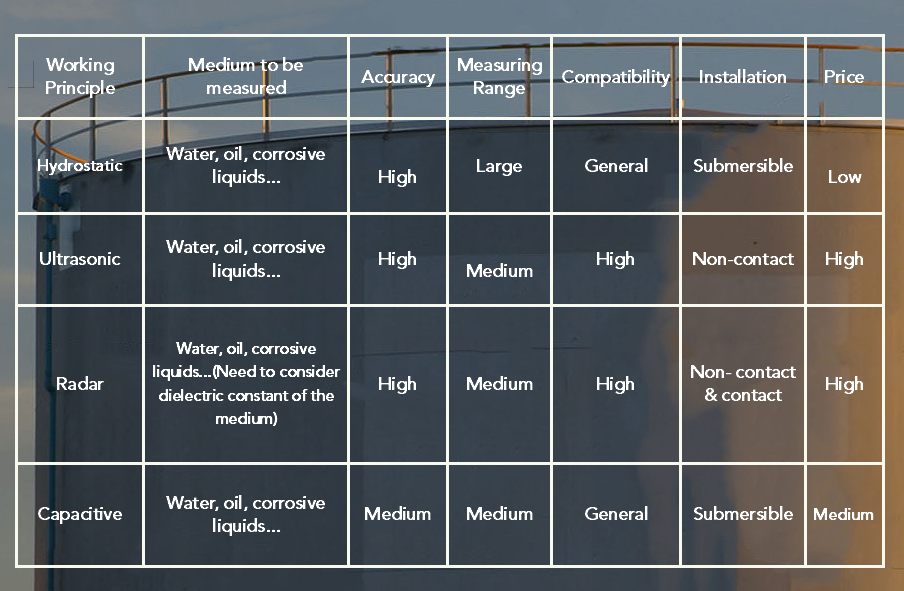How to Select the Right Level Sensor for Tanks
Due to the complexity and variability of the liquid level detection technologies, how to choose a suitable tank level sensor has always been an issue to engineers. For example: to monitor the impurity-contained wastewater, highly corrosive liquids, high viscosity liquids, foam-contained liquids…, which level detector should be chosen?
Currently on the current market the four most common monitoring technologies for liquid level in tanks include ultrasonic level sensors, radar level sensors, hydrostatic level sensors, and capacitive level sensors.
Four Most Common Liquid Level Monitoring Technologies

Before identify which tank level sensor is used, we need to sort out the following.
1. Medium to be measured: its characteristics and state, such as corrosiveness, viscosity…
2. Accuracy: Determine the accuracy level according to the actual process requirements and measurement purposes.
3. Range(tank height): the max of the actual liquid level.
4. Compatibility: Whether it is necessary to measure different media at the same time.
5. Installation method: Different level gauges and working conditions require different installation methods.
6. Your budget.
Let's learn and compare the four level sensors in detail.
Ultrasonic Level Sensors
Ultrasonic level sensors work by the Time of Flight (TOF) principle using the speed of sound. The measurement is precise and non-contact with the advantages of easy installation, high flexibility, not affected by the material to be measured. However, ultrasonic sensors do NOT work fine in containers with foam, steam, dust, vacuum and geometric shapes. Besides, some space should be left at the top of the container, so the container cannot be full.
Radar Level Sensors
The working principle of radar level sensor is a function of TDR. The accuracy and stability are good. In addition, it is easy to install and calibrate, with good flexibility. They can be used to measure applications with foam, dust, and even stirring. When using radar, the dielectric constant of the medium needs to be considered, and there are also requirements on the installation position and flange height. Like ultrasonic sensors, radar level gauges have also blind spots.
Hydrostatic Level Sensors
This is to use submersible level sensors installed at the bottom to detect the liquid pressure at the bottom, and convert and calculate the liquid level height. It is suitable for almost all media, and has the advantages of easy installation, wide popularity and low cost, but the measurement is greatly affected by the density and temperature of the medium, and calibration is required during the conversion process.
Capacitive Level Sensors
Since different media have different dielectric constants, capacitive level sensors measure specific values as the liquid level of the medium increases or decreases by sensing changes of capacitance in the container. They can be used for various chemical liquids, highly viscous substances, food, pharmaceutical and mechanical engineering industries… They have the advantages of accuracy, stability and reliability, provided that the medium is calibrated to a certain extent.
The following also sorts out the basic difference of different level sensors.

In general, we know the working principles, Pros and Cros, the specific applications and the medium, including measuring range, temperature, pressure and the characteristics of the liquid, such as the medium state, chemical aggressiveness, viscosity, whether it contains impurities, whether hygiene certification is required…
For example, during the filling process of daily chemical cream, it is necessary to monitor the high and low liquid levels of the storage tank. First we know that the cream is a liquid, highly viscous, non-corrosive, no food hygiene certification, so we can choose radars and ultrasonic sensors.
You can also contact us for recommending you the most suitable tank level sensor.





